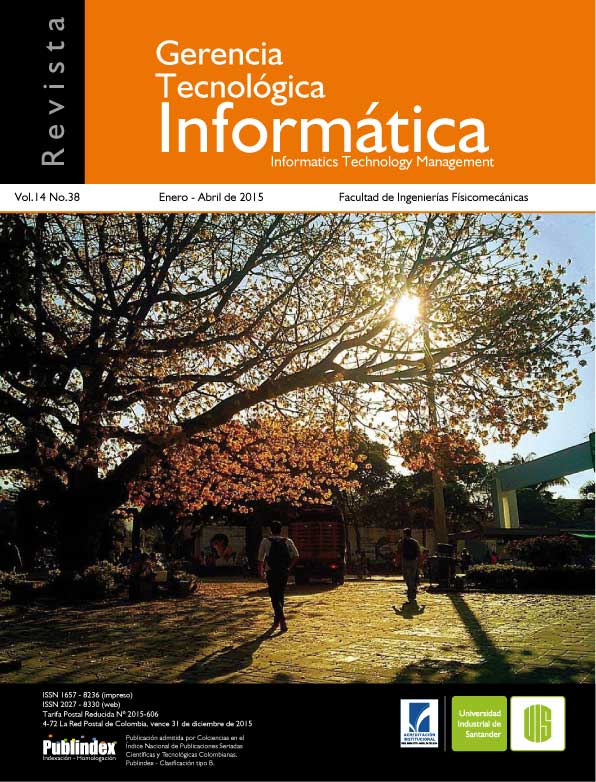Published 2014-10-28
How to Cite
Abstract
BIM, stands for Building Information Modeling. It is the natural evolution following CAD, Computer Aid
Design. While the methods used by CAD or BIM lead to the development of technical data used for the
construction of an urban or architectural Project, BIM transcends into the idea management system in
which information technology plays an important role as a means the conception, design, construction,
management and overall, the Project management of the construction sector. Although management systems applied to the construction industry have had signifcant progress globally in recent years, its presence in Colombia is incipient and except for some rare examples which begin to have leadership thanks to its high level of competitiveness, widespread resistance to change is maintained. How to overcome the lethargy in the management of projects in the construction sector? Has as objective the approach of strategies to accelerate technology transfer BIM since the hypothesis on increasing levels of competition from the implementation of information systems technology management. The paradigm shift includes strategies where BIM as a teaching or understanding of the
construction management can lead to elevated quality indicators in the building sector.
KEYWORDS: BIM, Building Information Modeling, Building Project Management.
Downloads
References
- Ayala, R. (2008). “La metodología fenomenológicohermenéutica de M. Van Manen en el campo de la investigación educativa. Posibilidades y primeras experiencias”. En: Revista de Investigación Educativa. Vol 26, No 2.
- Denzer, A. y K.E. Hedges, K. (2008) From CAD TO BIM: Educational Strategies for the Coming Paradigm Shift. En BUILDING INTEGRATION SOLUTIONS. Memoria del 2008 Architectural Engineering National Conference. Septiembre 24- 27, en Denver, Colorado. En:http://books.google. com.co/books?id=oHuvlq8n1z4C&printsec=frontc over&hl=es#v=onepage&q&f=false
- Barlish, K. (2012). How to Measure the Benefits of BIM. Charleston, South Carolina: BiblioBazaar. En:http://books.google.com.co/books?id=No6KMAEACAAJ&dq=BIM&hl=es&sa=X&ei=M82OUqbM AsL_kAfU14CIAg&redir_esc=y
- Bonilla, M. (2006). Innovación y transferencia de tecnología: Retos para Colombia. En: Colombia aprende, la red del conocimiento. Ministerio de Educación Nacional. En: http://www. colombiaaprende.edu.co/html/mediateca/1607/ article-115000.html
- Carrasco, J. (2004). Una didáctica para hoy, cómo enseñar mejor, Madrid: RIALP. En: http://www. casadellibro.com/libro-una-didactica-para-hoycomo-ensenar-mejor/9788432135095/983858.
- Carrillo, E., Arias,C., Arenas, P. & Flórez, L. (2013). Aproximación al sistema regional de ciencia, tecnología e innovación del departamento de Santander. Revista: Gerencia Tecnológica Informática, Vol 12 Num34, 45-58.
- Coloma, E. (2008). Introducción a la tecnología BIM. Barcelona: UPC. En: http://www.fic. org.mx/Eventos/Conferencias20aniversario/ Presentaciones/BIM_Intro.pdf
- Deutsch, R. (2011). BIM and Integrated Design. Hoboken, New Jersey:John Wiley & Sons, Inc. En: http://books.google.com.co/books?id=pYtxLE5ivlsC&printsec=frontcover&dq=BIM&hl=es &sa=X&ei=PsqOUvClHpDTkQey4oCQDA&redir_ esc=y#v=onepage&q=BIM&f=false
- Epstein, E. (2012) Implementing Succesful Building Information Modeling. Norwood, Massachusetts: Artech House. En: http://books.google.com.co/bo oks?id=9cGgKsQyiB8C&dq=BIM&hl=es&source= gbs_navlinks_s
- Hardin, B. (2009). BIM and Construction Managemenr: Proven Tools, Methods, and Wrokflows. Indianapolis: Wiley Publishing. En: http://books.google.com.co/books?id=pduhGy cNlZMC&printsec=frontcover&dq=BIM&hl=es& sa=X&ei=PsqOUvClHpDTkQey4oCQDA&redir_ esc=y#v=onepage&q=BIM&f=false
- Jernigan, F. (2008). Big BIM, Little Bim: The practical Approach to Building Information Modeling: Integrated Practice Done the Right Way! Salisbury, Maryland : 4Site Press. En: http:// books.google.com.co/books?id=5DiLQwAACAAJ&dq=BIM&hl=es&sa=X&ei=RMuOUqm3EM3SkQeD iYHIBw&redir_esc=y
- Krygiel, E. Nies,B. (2008). Green BIM: Successful Sustainable Design with Building Information Modeling. En: http://books.google.com.co/book s?id=2Nia6A4G0uQC&dq=BIM&hl=es&source=g bs_navlinks_s
- Kumar, S. (2008) Interoperability between building Information Models (BIM) and energy analysis programs. Ann Arbor, Michigan: ProQuest LLC. En: http://books.google.com.co/books?id=N ovYFQToxHoC&printsec=frontcover&dq=BIM&hl= es&sa=X&ei=RMuOUqm3EM3SkQeDiYHIBw&red ir_esc=y#v=onepage&q=BIM&f=false
- Kymmell, W. (2007). Building Information Modeling: Planning and Managing Construction Projects with 4D CAD Simulations. New York: Mc Graw Hill Professional. En: http://books.google. com.co/books?id=vV8qgetzBQEC&pg=PR2&vq=B IM&dq=BIM&hl=es&source=gbs_selected_pages &cad=2#v=onepage&q=BIM&f=false
- Levy, F. (2011). BIM in Small-Scale Sustainable Design. Hoboken, New Jersey:John Wiley & Sons, Inc. En:http://books.google.com.co/book s?id=lMF9DS8abagC&dq=BIM&hl=es&source=g bs_navlinks_s
- Marulanda, C., López, M. & Mejía, M. (2013). Análisis de la gestión del conocimiento en pymes de Colombia. Revista: Gerencia Tecnológica Informática, Vol 12 Num33, 33-43.
- Medina, Y., Rico, D. (2012) Mejores prácticas de gestión para la calidad de los servicios en tecnologías de información. Revista: Gerencia Tecnológica Informática, Vol 11 Num29, 47-57.
- Ningappa, G. (2011). BIM a Lean Tool? Use a Lean and Building Information Modeling (BIM) in the Construction Process; Does BIM make it Leaner?. Saarbrücken, Alemania: LAP Lambert Academic Publishing. En: http://books.google.com.co/book s?id=U2glywAACAAJ&dq=BIM&hl=es&sa=X&ei=i 8yOUonwNcTPkQe-m4G4Dg&redir_esc=y
- Ocampo, J. (2013). “Didáctica y Percepción de la Arquitectura”. En: Revista HITO No 27, Bogotá: Asociación Colombiana de Facultades de Arquitectura.
- Ortega, H., Muñoz, S. & Díaz, E. (2012) Propuesta para impulsar el desarrollo de aplicaciones convergentes en Colombia. Revista: Gerencia Tecnológica Informática, Vol 11 Num30, 15-24.
- Pramod, R. (2011). BIM for Building Owners and Developers: Making a Business Case for Using BIM. Hoboken, New Jersey:John Wiley & Sons, Inc. En: http://books.google.com.co/books?id=53MqxPkg DOYC&dq=BIM&hl=es&source=gbs_navlinks_s
- Rojas, T., Sierra, L., Villegas & J. Meza, E. (2013) Integración metodológica para el desarrollo de recursos educativos informáticos para apoyar la enseñanza del Nasa Yuwe. Revista: Gerencia Tecnológica Informática, Vol 12 Num32, 45-60.
- Race, S. (2012). BIM Demystified. New York: Taylor & Francis. En: http://books.google.com.co/ books?id=9LJ8MAEACAAJ&dq=BIM&hl=es&sa=X &ei=HcyOUqaTEY3IkAe1g4CYBw&redir_esc=y
- Saldarriaga, A. (2011). Enseñanza de la Arquitectura en Colombia, Estado Actual. Bogotá: Asociación Colombiana de Facultades de Arquitectura. En: http://scabogota.com/acfa3/ images/publicaciones/estudio_nacional.pdf
- Sierra, L., Mosquera, L. & Andrade, D. (2013). Guía para apoyar la priorización de riesgos en la gestión de proyectos de tecnologías de la información. Revista: Gerencia Tecnológica Informática, Vol 12 Num33, 15-32.
- Smith, D., Tardif, M. (2012) Building Information Modelon: A strategic Implementation Guide for Architects, Engineers, constructors, and Real Estate Asset Managers. Hoboken, New Jersey:John Wiley & Sons, Inc. En: http://books.google.com.co/books?id=gQ- 6gcoU6J4C&dq=BIM&hl=es&source=gbs_ navlinks_s
- Torres, Raúl. (2003) Los nuevos paradigmas en la actual revolución científica y tecnológica. Ed. EUNED. Costa Rica. Libro.
- Van Manen, M. (2003). Investigación Educativa y Experiencia vivida. Ciencia humana para una pedagogía de la acción y de la sensibilidad. En: <http://www.casadellibro.com/libroinvestigacion-educativa-y-experiencia-vividaciencia-humana-para-una-pedagogia-de-laaccion-y-la-sensibilidad/9788482362830/927799> Consultado en 14/05/2014.
- Weygant, R. (2011). BIM, Content Developent. Standards, Strategies, and Best Practices. Hoboken, New Jersey:John Wiley & Sons, Inc. En: http://books.google.com.co/books?id=s1Ck Is8r8fgC&printsec=frontcover&dq=BIM&hl=es&sa=X&ei=PsqOUvClHpDTkQey4oCQDA&redir_ esc=y#v=onepage&q=BIM&f=false
- Woolgar, Steve. (2010). ¿Sociedad virtual? Tecnología, “Cibérbole”, realidad. Ed. UOC. Barcelona.
